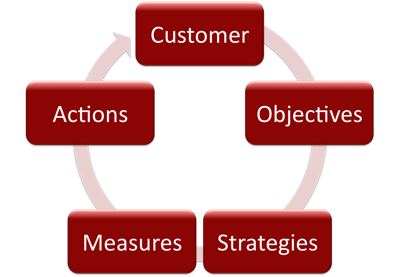Solving for "Why": The Myth of More
 Business, and marketing specifically, often focuses on “more.” But here’s a question for you: Is more always better?
Business, and marketing specifically, often focuses on “more.” But here’s a question for you: Is more always better?
I’d argue that cases exist where “more” isn’t always a good thing, at least not in itself. Let me give you an example.
A company I worked with recently (they’ve given me permission to share this), called me in because they’d launched a promotion designed to bring in more traffic and, they hoped, more sales.
They’d achieved the first goal; traffic to their site skyrocketed. But… something went wrong. Their revenues didn’t increase. In fact, they fell.
What went wrong?
Hang with me for a second and I’ll explain.
First, there’s a fairly simple model I’ve used for years for evaluating e-commerce strategies and tactics that looks like this:
Revenue ( R ) = Visitors ( V ) times Frequency ( F ) times Conversion ( C ) times Purchase Value ( P )
Or, more simply:
Revenue = V * F * C * P
If you want to increase your revenues, you can increase:
- The number of visitors your site gets
- The frequency those visitors come to your site
- The conversion rate among those visitors (you can bone up on what conversion rate is here)
- The value of the transaction from those visitors who convert
- Some combination of the above (there are 11 possible combinations, in case you’re curious)
Increase one or more of these numbers and you can expect your revenue to grow. And the more of these four variables your chosen initiative affects, the more likely you are to increase revenues. Which, you know, is kind of the point. This model also works for ad-supported businesses with just a little finessing.
Too often, businesses look to grow one of these numbers in isolation from the others (a problem I’ve discussed at length here and here). Occasionally, this isolated focus occurs because companies “silo “teams, for instance making one group responsible for promotional tactics and another responsible for improving site functionality.
Fortunately, that wasn’t the case here. Unfortunately, the tactic the company had chosen—creating so-called “link-bait” content designed to increase the number of sites linking in, improve their search engine ranking, and grow traffic—did increase their traffic, but it didn’t consider any other component of the model. And ignoring the other elements caused the overall decline they experienced.
So what went wrong?
Well, a few things:
- The content wasn’t particularly relevant to their business. While the content was well written, eye-catching and increased their traffic, almost none of the new traffic converted.
- The new visitors rarely returned to the site. The client’s frequency metrics fell pretty sharply as the “new” visitors almost never came back to the site a second time.
- The new content distracted long-time customers. Not only did the new content not encourage repeat visits or purchases, it actually distracted the company’s existing site visitors from their initial purchase intent, hurting conversion rate.
- The additional traffic slowed their site response. A couple of their pieces got picked up by larger content aggregators and the added volume hurt site stability, which impacted sales during peak periods. Worse, their operating expenses increased because of the need to improve server capacity (while the cost of a single additional visitor is essentially free—low marginal cost, in economic terms—the cost of a 2.5x volume increase was not).
Fortunately, none of these were long-term problems. By shifting focus from “more traffic” to “more qualified traffic,” we were able to re-engage existing customers, improve conversion rates, and drive higher purchase values from visitors to the site (visit frequency returned roughly to pre-link bait campaign levels). Result: happy customers and happy business owners.
Now, does that mean “more traffic” is a bad goal? Or “more” anything, for that matter?
Not at all.
But you’ve also got to consider what you want those visitors (or what-have-you) to do when they arrive at your site and whether they’re drawn from new visitors or people you’ve already engaged with—or, of course, both.
So when you’re thinking about “more,” think also why you want more. Then align your objectives, strategies, and tactics with solving for “why.”
If you’re interested in learning more about the future of e-commerce and marketing via the social, local, mobile web, register to receive a special report I’ve produced in conjunction with hotel marketing firm Vizergy, “Digital Hotel Marketing in a Multiscreen World.” While it’s targeted specifically at hotel and resort marketers, the lessons apply to just about any business. You can get your free copy of the report here.
You might also enjoy some of our past coverage of the social, local, mobile web and what it means for your business, including:
- 3 Key Trends for 2013
- 2013 trends: It’s all e-commerce (Small Business E-commerce Link Digest)
- Why E-commerce Keeps Growing. And Why it Still Will. Thinks Out Loud Episode 39
- The Zen of Digital Marketing Strategy
- The Myths of Mobile Marketing
- The future of real-world mobile commerce
- 4 Fundamental Truths About the Future of E-commerce
- What’s the Future of E-commerce? Look to the Past to Find Out

This Post Has 0 Comments